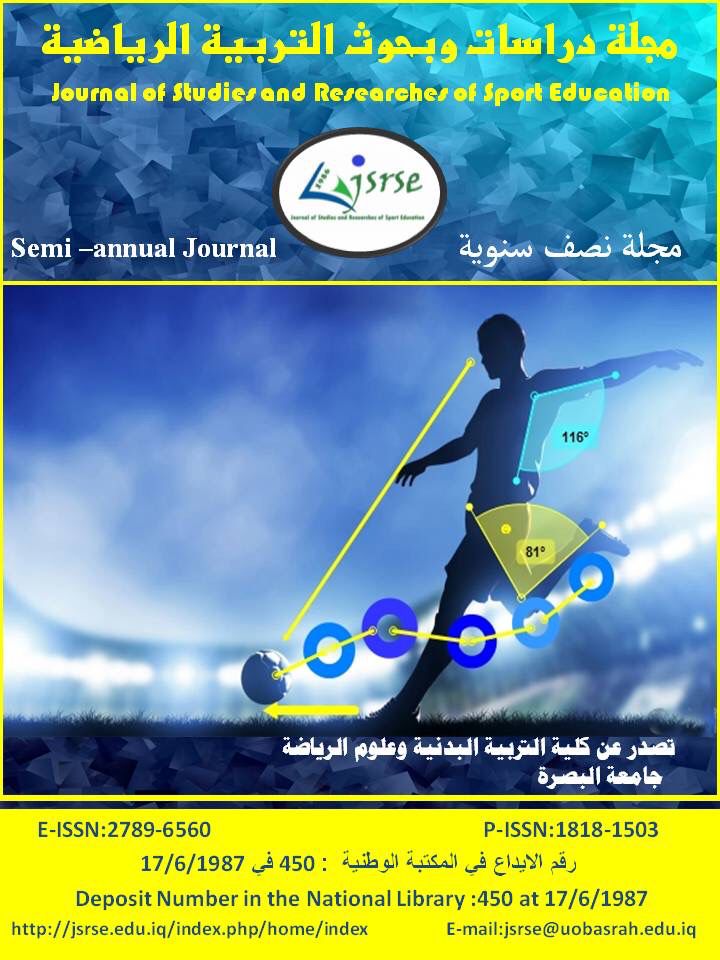The Relationship of Sensory-Motor (Spatial) Perception and Cognitive Achievement with the Accuracy of Performing Some Basic Skills in Badminton
Main Article Content
Abstract
The importance of the research lies in providing the spatial kinesthetic perception and cognitive aspects of the student in order to notice the sudden problems that occur during playing and to develop appropriate solutions for them by the students, and this leads to raising the student’s level in terms of skill, and the research aimed to identify the kinesthetic perception (spatial). ) and the cognitive achievement of some skills and the relationship between them, and the researchers used the descriptive approach to suit the nature of the research. The research community consisted of students of the fourth stage at the Faculty of Physical Education and Sports Sciences / Salah al-Din University for the academic year (2021-2022), totaling (121) male and female students, the research sample consists of (male) students from the original research community at a rate of 33%, who are (40) students. After conducting the exploratory experiment on (8) students from the main experiment and extracting the scientific laboratories of (honesty and reliability), the main experiment was conducted on a sample of (32) students after extracting the sample of the exploratory experiment on 8/5/2022. Analysis of the results by statistical means and the statistical bag spss, and one of the most important results is the existence of a significant correlation between some tests of sense-spatial cognition with some basic skills in badminton and the cognitive achievement of students.
Article Details

This work is licensed under a Creative Commons Attribution-NonCommercial 4.0 International License.
References
Kmash, Y. L. and M. R. M. (2013). Measurement and Testing in Physical Education: Vol. 1st edition. Al-Kitab Publishing Center.
Abbas, I. F. (2016). Sensory-kinesthetic perception and its relationship to some elements of physical fitness and skill traits of badminton players. Journal of Physical Education Sciences.
Abdul-Hussain Abbas Zaki, Aldewan, L. H., & Abdel-Amir, A.-H. (2021). The reality of electronic badminton education in light of Covid 19 from theviewpoint of students of some colleges of education Physical and sports sciences in Iraqi universities. Journal of Studies and Researches of Sport Education, 69, 319–332. https://www.iasj.net/iasj/article/213047
Ali, A. H. and O. S. S. (2016). Social intelligence and its relationship to some motor abilities and cognitive achievement in badminton for students. Ali, Ali Hussein; Omar, Shanka Suleiman , Volume 9(Number 3). https://doi.org/10.33984/0904-009-003-018
Al-Janabi, S. H. (2019). The effect of a proposed program on the development of kinesthetic perception (of time and distance) and the level of general performance in swimming. The First Scientific Conference.
Al-Rubaie, N. S. (2000). The effect of training curricula in developing the explosive power and the speed-distinguishing force of the arms on the throwing power and shooting accuracy in handball. University of Baghdad.
Al-Saeed, R. (2018). Thesis Title 1-Hip and knee joints biomechanics of karate players during training and competition style kicks.
Al-Saeed, R., & Pain, M. T. G. (2017). Descriptive analysis of hip and knee joint loading during reverse roundhouse kick (hook) karate kick performed in training and competition modes. ISBS Proceedings Archive, 35(1), 9.
Al-Saeed, R., Pain, M. T. G., & Lindley, M. (2016). HIP AND KNEE LOADING OF KARATE PLAYERS PERFORMING TRAINING AND COMPETITION STYLE VERSIONS OF A ROUNDHOUSE KICK. ISBS-Conference Proceedings Archive.
Al-Shamaa, H. F. (2015). A study of the relationship between spatial perception and the performance of the effectiveness of the triple jump for beginners at the ages of 13-14 years. Journal of the College of Physical Education, Volume 28(Number 1).
Asar, S., Rahavi Ezabadi, R., Shojaei Baghini, A., & Maleksabet, N. (2022). The Relationship Between Reaction Time, Eye-Hand Coordination with Visual Field in Elite Tennis Tennis Players. Asian Journal of Sports Medicine, 13(2). https://doi.org/10.5812/asjsm-115787
Chen, Y.-L., Hsu, J.-H., Tai, D. H.-L., & Yao, Z.-F. (2022). Training-Associated Superior Visuomotor Integration Performance in Elite Badminton Players after Adjusting for Cardiovascular Fitness. International Journal of Environmental Research and Public Health, 19(1), 468. https://doi.org/10.3390/ijerph19010468
Jawad, A. S. and J. M. H. (2008). Statistics and its applications in the mathematical field using the SPSS program. Al-Ghari Al-Hadith Press.
Melhem, S. M. (2002). Measurement and Evaluation in Education and Psychology, 2nd Edition: Vol. yes (2nd Edition). Dar Al Masirah for Printing and Distribution.
Mustafa Abdel Reda Kazem, Aldewan, L. H., & Azal, Y. H. (2021). The effectiveness of the formative learning model in raising the level of cognitive achievement of swimming subject for first-stage students. Journal of Studies and Researches of Sport Education, 69, 11–22. https://www.iasj.net/iasj/article/213027





 IASJ
IASJ CC-BY-4.0
CC-BY-4.0 turnitin
turnitin ISSN
ISSN DOAJ
DOAJ Crossref
Crossref GoogleScholar
GoogleScholar Orcid
Orcid